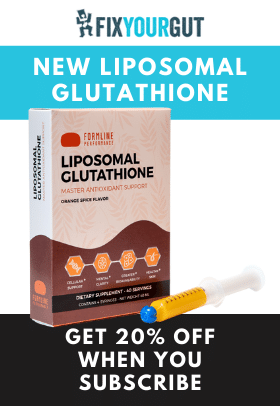When I started researching the Advanced Orthomolecular Research Probiotic 3 supplement for this blog post, I believed that one of the bacteria in it, Clostridium butyricum was extremely beneficial. No probiotic supplement is best for everyone. However, when you formulate potentially pathogenic strains that are difficult to reduce if they become pathogenic in a “probiotic” supplement, something must be said. Like most HSO probiotic supplements on the market (except the new version of Prescript Assist) the following probiotic supplement has helped some people recover their digestive health. Though I do not recommend it, I do not outright say it is dangerous and has no merit. It has, however, worsened the digestive health of some people as well and has the potential of causing hospitalization from dysbiosis or worse.
Advanced Orthomolecular Research – Probiotic 3, the Good, the Bad, and the Ugly
First, I want to start by stating that I admire the company that produces Probiotic 3, Advanced Orthomolecular Research. I frequently recommend the use of some of their supplements. Doctor Traj Nibbler started AOR because he was contacted by advocacy groups for people with AIDS to help locate hard to find supplemental formulations to improve their health. Dr. Nibbler discovered that it was difficult to source dietary supplements especially of high quality in large quantities. He decided to start sourcing and compounding his own brand of supplements for the people in the advocacy groups. Dr. Nibbler then begun to standardize some of his formulas and eventually founded the company Advanced Orthomolecular Research to sell quality supplements around the world. AOR brought many essential supplement advancements to the market including D-Ribose, Benfotiamine, sustained release R-lipoic acid, and oxaloacetate (benaGene). I have recommended these supplements in the past to many of my clients, and I am glad that AOR made them widely available to the public.1
Clostridum Butyricum, a “Promising” Probiotic with Sickening Potential
I believed in the past that Clostridium butyricum might be an important “probiotic” for supplementation. One of the bacterial strains that are not included in most probiotic supplements, but I thought should be. The bacteria at first glance appears to be important for proper digestive health. It produces the short chain fatty acid butyrate. Butyrate is a significant energy source for colonic cells, anti-cancerous, increases mitochondrial activity, helps maintain proper integrity of the gut mucosal barrier, reduces inflammation, and improves microbiome health by reducing the chance of developing dysbiosis. C. butyricum is a strictly anaerobic endospore-forming Gram-positive bacteria that is a soil inhabitant in various parts of the world. C. butyricum is also found in our gut microbiome, up to 10-20% of the samples. Though C. Butyricum has been used as a probiotic in Asian countries, it is also known to cause opportunistic infections including dysbiosis, chronic diarrhea, sepsis, foodborne illness, and rarely botulism and necrotizing enterocolitis.2 3 4 5 6
“In 1986, the first infant botulism case caused by a BoNT/E-producing C. butyricum strain was reported in Italy. Since then, C. butyricum has been associated with botulism in other countries (i.e. China, India, Japan, Ireland, and the USA).“7
“NEC is a devastating gastrointestinal disease-causing high morbidity and mortality, affecting predominantly preterm neonates during outbreaks. Its clinical presentation is characterized by abdominal distension, gastrointestinal bleeding, mucosal ulcerations and necrosis, portal venous gas, and pneumatosis intestinalis, with different degrees of severity. Despite decades of research, the pathogenesis of NEC remains elusive. Although no aetiological microorganism has been definitively established, the most often implicated bacteria have been Clostridium species. Howard et al. first described an association between C. butyricum and NEC in 1977. They identified C. butyricum in blood and stool cultures in nine of ten preterm neonates during an outbreak of NEC. In another study, Gorham et al. reported the presence of C. butyricum on the hands of members of the medical and nursing staff during an NEC outbreak. This was consistent with the effectiveness of preventive measures in controlling such outbreaks. Additionally, Sturm et al. demonstrated a cytotoxic effect of the supernatant of a C. butyricum strain isolated from a preterm neonate with NEC. Recently, Smith et al.detected the presence of C. butyricum with high density in two surgical samples from preterm neonates with NEC. Both specimens were characterized by histological pneumatosis intestinalis. In a previous study, we analysed 30 stool samples from preterm neonates with and without NEC by using 16S rRNA pyrosequencing and culture-based methods, and 163 samples by using C. butyricum qPCR ; C. butyricum was specifically associated with NEC, and culture supernatants of C. butyricum strains from preterm neonates with NEC showed significant cytotoxic activity“8
“A new pathogenic C. butyricum strain (NOR33234) has recently been isolated from an elderly patient with antibiotic-associated diarrhoea; tests for C. difficile toxins gave negative results.“9
“To the best of our knowledge, only one case has been reported of C. butyricum bacteraemia and sepsis, which occurred in an injecting drug user.“10 11
There are many different individual strains of the bacteria, some containing more virulence factors than other strains. The strain used in Probiotic 3 is Clostridium butyricum TO-A. C. butyricum TO-A has been shown in one study to potentially reduce inflammation in the colon by deactivating toll-like receptor 4 (TLR4) by the production and utilization of butyrate. TLR4 is a protein when activated leads to a release of nuclear factor kappa-light-chain-enhancer of activated B cells and inflammatory cytokines that activate the innate immune system and sometimes trigger beneficial inflammation. Lipopolysaccharide (LPS) a component of the cell wall of Gram-negative bacteria activates the production of TLR4. An overactivation of TLR4 can trigger excessive inflammation in the digestive tract leading to leaky gut (by weakening the gut junctions), inflammatory bowel disease, and even colorectal cancer if prolonged and severe enough. C. butyricum TO-A supplementation sounds like a good idea if you are dealing with leaky gut, colorectal cancer, or uncontrolled intestinal inflammation, but I do have some issues with suggesting the use of the probiotic in people suffering from these conditions.12
The most common C. butyricum “probiotic” used for supplements is Clostridium butyricum MIYAIRI 588. C. butyricum MIYAIRI 588 has been tested and does not appear to contain any toxin genes and showed antibiotic sensitivity. “Safety studies of this probiotic strain have been conducted and include assessment of antimicrobial sensitivity, documentation of the lack of Clostridium toxin genes, and evaluation of CBM 588®on reproductive and developmental toxicity in a rodent model. With the exception of aminoglycosides, to which anaerobes are intrinsically resistant, CBM 588® showed sensitivity to all antibiotic classes important in human and animal therapeutics. In addition, analysis of the CBM 588® genome established the absence of genes for encoding for α, β, or ε toxins and botulin neurotoxins types A, B, E, or F. There were no deleterious reproductive and developmental effects observed in mice associated with the administration of CBM 588®. “ The only study we have on its virulence ability however was founded by the pharmaceutical company that produces the probiotic strain, Miyarisan Pharmaceutical Co. LTD, Tokyo, Japan. So before I recommend this strain more studies should be performed without the financial sponsorship of the production company before I can recommend the strain. The Clostridium strain that is in Probiotic 3, C. butyricum TO-A, has no virulence testing performed that is published to my knowledge, so it is unknown if the strain is pathogenic or contains the ability to inherit pathogency.13 14
It might be possible for C. butyricum TO-A to obtain virulence potential from other bacteria through horizontal gene transfer. Horizontal gene transfer is the movement of genetic material between unicellular organisms, which can occur from bacteria to bacteria contact, transduction (bacterial DNA being transferred by a virus), or through transformation (when bacteria take components of dead bacteria or organism DNA into their genetic makeup). C. butyricum can inherit the ability to cause botulism. “Notably, the operon encoding the BoNT/E toxin harboured by the neurotoxigenic C. butyricum strains is very similar to that carried by group II type E toxin-producing C. botulinum strains. The presence of the BoNT/E toxin gene within either plasmids or the chromosome in different Clostridium species is consistent with horizontal transfer events mediated by plasmids or phage, and recombination events mediated by mobile genetic elements such as transposons.” Finally, it is possible for C. butyricum to acquire virulence factors from C. difficile leading to chronic diarrhea.“Among the proteins annotated from genome sequencing of this strain, there was an enterotoxin (OA81_00270). Moreover, two annotated proteins had sequence similarity to phage holins in C. botulinum. A previous report has shown that holin-like tcdE is required for exporting enterotoxins tcdA and tcdB in C. difficile. Whether the enterotoxin or holin plays a pathogenic role in C. butyricum infection remains to be examined.”15 16
Enterococcus Faecium, Avoid Supplementation at All Cost
Enterococcus faecium is a Gram-positive bacterium that is a commonly found opportunistic bacteria in our digestive tract. E. faecium is known to cause sepsis, endocarditis, and urinary tract infections. Most strains of E. faecium also have multi-drug antibiotic resistance and show resistance to hand washing and alcohol sanitization. Forty percent of medical intensive care units reportedly found that 80% to 90.4%, of device-associated infections (central lines, prosthetic heart valves, ventilators, and urinary catheters) were due to vancomycin and ampicillin resistant strains of E.faecium. Enterococci bacteria account for at least 12% of nosocomial (hospital) infections in the United States. Vancomycin and ampicillin resistant strains of E. faecium might be susceptible to the antibiotics linezolid, quinupristin-dalfopristin, and daptomycin. The strain of E. faecium used in Probiotic 3 is Enterococcus faecium TO-A.17 18 19 20
It is unknown if Enterococcus faecium TO-A contains any virulence factors associated with E. faecium. We do know that one of the common probiotic strains of E. faecium, E. faecium T-110 has virulence factors can produce biofilm, evade the immune system (anti-phagocytosis), produce hyaluronidase enzyme that breaks down tissue to increase virulence), and adhere to specific bodily tissues (gastrointestinal tract and the heart). Even the supposed “non-pathogenic” strain E. faecium NRRL can produce biofilm, evade the immune system (anti-phagocytosis), and adhere to specific bodily tissues (gastrointestinal tract and the heart). In studies antibiotic resistance has been inherited from horizontal gene transfer and maybe possibly virulence factors from other Enterococci including E. faecalis.21
You might be asking yourself, why include such an “opportunistic” bacterium in a probiotic “supplement”? I thought about it for a while. The only reason I can think of is to reduce the colonies of other “weaker” opportunistic strains that are causing digestive issues in the hope you improve. The risk of relieving bacterial dysbiosis and potentially causing another dysbiosis that could be worse using this bacterium is too great of a risk if you ask me.
Finally, Probiotic 3 Contains the HSO “Probiotic” Bacillus Subtilis
I have written about Bacillus subtilis previously. Probiotic 3 uses the strain Bacillus subtilis TO-A and it’s virulence potential is unknown currently, therefore I do not recommend it.
Final Thoughts
Though I like Advanced Orthomolecular Research and recommend many of their supplements I cannot recommend their main probiotic supplement, Probiotic 3. The opportunistic potential of the three bacteria that are used in the probiotic, C. butyricum, E. faecium, and B. subtilis is too high. If you have taken Probiotic 3 and it is helped or harmed your health please let me know in the comment section of the blog.
See more from this series:
- https://aor.us/about-us ↩
- https://www.sciencedirect.com/science/article/pii/S1198743X15009143 ↩
- https://www.ncbi.nlm.nih.gov/pmc/articles/PMC3070119/ ↩
- https://www.ncbi.nlm.nih.gov/pmc/articles/PMC4903954/ ↩
- https://www.selfhacked.com/blog/butyrate-health-benefits-butyrate-derivatives-sodium-butyrate-phenylbutyrate-trybutyrine-butyric-acid-butyrate-prodrugs-butyrate-producing-bacteria/ ↩
- https://www.nature.com/articles/s41398-017-0089-z ↩
- https://www.sciencedirect.com/science/article/pii/S1198743X15009143 ↩
- https://www.sciencedirect.com/science/article/pii/S1198743X15009143 ↩
- https://www.sciencedirect.com/science/article/pii/S1198743X15009143 ↩
- https://www.sciencedirect.com/science/article/pii/S1198743X15009143 ↩
- http://jmm.microbiologyresearch.org/deliver/fulltext/jmm/57/2/236.pdf?itemId=/content/journal/jmm/10.1099/jmm.0.47578-0mimeType=application/pdf ↩
- https://www.ncbi.nlm.nih.gov/pubmed/17404865 ↩
- https://www.ncbi.nlm.nih.gov/pubmed/26437792 ↩
- http://www.miyarisan.com/english_index.htm ↩
- https://www.ncbi.nlm.nih.gov/pmc/articles/PMC4187160/ ↩
- https://www.sciencedirect.com/science/article/pii/S1198743X15009143 ↩
- https://academic.oup.com/cid/article/32/9/1384/292320 ↩
- https://www.semanticscholar.org/paper/First-complete-genome-sequence-of-a-probiotic-T-110-Natarajan-Parani/93be6725d9aa6cb11eab10af238b4f0793bbb6a1 ↩
- https://www.ncbi.nlm.nih.gov/pmc/articles/PMC4492516/ ↩
- https://www.ncbi.nlm.nih.gov/books/NBK190429/ ↩
- https://www.semanticscholar.org/paper/First-complete-genome-sequence-of-a-probiotic-T-110-Natarajan-Parani/93be6725d9aa6cb11eab10af238b4f0793bbb6a1 ↩







What was in the research please? No updates since 2019
Hi John, is the CBM 588 same as this product?
https://www.amazon.co.jp/-/en/Strong-Miyarisan-Tablets-Designated-Quasi-drug/dp/B000FQUNBA/ref=sr_1_2?dchild=1&keywords=%E3%83%9F%E3%83%A4%E3%83%AA%E3%82%B5%E3%83%B3&qid=1633656370&sr=8-2
My daughter is very ill after six weeks on AORprobiotic 3. Who, what can help her, reverse the damage. Antidote please!!
I’m trying figure out will this help me with my Eczema that I have been suffering for the past 7 months now. 90% of my body is affected. I was on predisone for a whole month and it helped reduced my symptoms a lot but I’m trying to maintain and control my Eczema throughly eating, avoiding gluten, dairy, bad sugar, processed food and following my nutritionist supplements for the next 8 months. My nutritionist is recommending Dr.Mercola products, like complete probiotics, D3+K2 which are super expensive. So I’m trying to see if other products can be used. I already use VivaNatural Omega3. Any help would be appreciated.
To be fair, these risks could be said about many probiotics. Bacteria all have a lot of highly related syrains, some of which can be pathigenic. So do we not eat any fermented foods because of that risk? You have to think about a population continuum and not absolute presence of virulence. When you have 100000000 organisms, there will always be some fraction that are virulent and could possibly share information through plasmids. I don’t think it is so simple. More likely it depends on some factors about the host that encourage or repress these strains. By taking non virulent strains you are likely outcompeting the virulent population and reducing risk of an infection. As far as I could find the only cases of NEC were in infants, with a very rare case in elderly. It seems strange that none are reported in normal healthy children or adults. It may be the lack of certain other organisms or something about the naive immune system of infants that makes them especially susceptible to problems. I agree that independent studies need to be done on these organisms, in fact it is quite urgent that someone do them because they may be crucial for some people to repair dysbiosis.
Dr. Mercola now sells his own brand of HSO probiotics. So does Dr. Axe. And now Dr. Hyman recommends Megasporbiotics. Thats a huge audience.
Are Dr. Mercola products recommended? My nutritionist recommends them but I see some Reddit post about him not being real doctor and just in it for the $$$
We had a fecal test done for our daughter, who was 6 at the time, to determine what was going on with her gut flora. All was balanced, but she was strangely missing Clostridium butyricum and Enterococci.
This was the only probiotic we could find to introduce with those strains! She did just fine with it. What are your thoughts on taking this probiotic if you happen to know there’s an absence of it in the gut?
Thank you for your informative post. I would appreciate if you may share your thoughts about Dr. Dietrich Klinghardt and his work. He consents and promotes sporebiotics. Ref. link to his his talk here: https://youtu.be/S_8penPDg6Q Knowing this, would you please share your thoughts?
My son cannot swallow pills designed to survive stomach acids and deliver product to intestine effectively! So delivery of traditional probiotics (Lactobacillus, Bifidobacterium, and yeast Saccharomyces) is ineffective. Any thoughts on how to counter this? Thank you so very much!
What about the use of probiotic enemas?
Use liquid probiotics
I appreciate your research on this, but I want to provide a counterpoint. Over the last 15 years I’d developed food intolerances for an ever-growing number of foods, including almost all fruits, anything with citric acid (even as a preservative), pumpkin, sesame, artichokes, and on and on. Whenever I ate anything on my ever-growing list, I had 24-48 hours of terrible headaches. I did a lot of research and discovered clostridium butyricum’s potential for reducing inflammation, helping with gut mucosa, and preventing leaky gut symptoms. I found AOR’s Probiotic-3 and it changed my life. I am now able to eat almost anything without the issues I used to have. So while it may have the opportunistic features you mentioned in some circumstances, it can also be incredibly helpful.
Hi John, what ya think? Well yes I will get ur book but in meantime—! We’re holding to hear ur expertness on this. Maybe I should also go with the Miyairi 588 too? Thank much for all the help u have given on this subject
best, Cindy
Hi John,
My allergy doctor recommended taking a probiotic that contain C. butyricum, he recommended Aor probiotic 3 but i haven’t taken because it has other strains as well. So i order the C.butyricum MIYAIRI 588 the one from japan on ebay. Do you think this one could cause any harm? I have ibs and acid refulx and doctor send me to an allergy doctor to see if i am allergic to something test came negative but doctor recommend this probiotic. now, reading your article not sure if it is safe to take. let me know your thoughts, i will appreaciate. Thank you!
Yes, though there are more studies with that specific strain it can still cause issues just like any form of C. butyricum under the right circumstances. I would not take it myself.
Hi John,
Hope all is well. I tried to send a message through the contact page but it was not working. We found this article and appreciate that you use AOR products. We read this in detailed and wrote a document explaining the details of Probiotic 3 and it’s ingredients. Could we share our findings with you to see if you are willing to update this article? Thanks in advance.
Alcides
Of course, I am willing to look at the data. [email protected]
Hi Alcides,
I am interested on you findings, My doctor recommend this probiotic but not sur eit will help or harm me. if you could share you finding that would be appreaciate. Thanks!
Depends on what the research is, my email is [email protected].